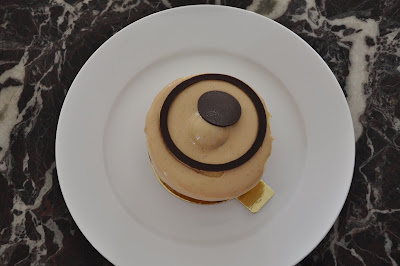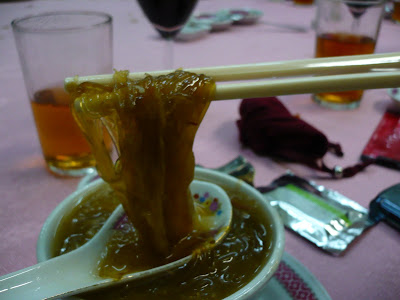Then there are those we've heard then laughed.
Private dining, that works on much the same principles as calling on geishas in Kyoto. No fresh faces; you have to be a guest of a regular. And just
because you've been there once does not warrant you a welcome: you have make a reservation through the regular, or become a regular yourself. And even if you are a regular, you still need to book months in advance.
Then there's the food.
It's not your regular fare.
A note of warning: if you're adverse to the consumption of certain seafood products such as dried shark fin, abalone, etc, LOOK AWAY NOW.
Yes, you read right, shark fin and abalone. Dried sea cucumber and fish maw are also available. And that's only what the new regulars know about. Old regulars, well...
But, once you have been there, you will understand the obsession with shark fins and abalone. And snake, sea cucumbers, goose feet and all the "wacky" food in Cantonese banquets.
Needless to say, this private dinner was unlike any other. The food speaks for itself.
Only the thickest, fleshiest part of the stomach of a pig (called the "sharp" stomach) was used, each stomach has about only a square inch or two which can be used. The thickness works well in providing not only flavour, but also texture, resulting in a tender but bouncy, totally ungamey and refreshed by the crispness and fragrance of Chinese celery. Chinese celery has a more intense, concentrated flavour than normal celery, and works well in countering the wok's breath, a deep, smokey aroma that rounded off the whole dish. Even though I'm not normally a fan of offal, this was absolutely fantastic.
I know, we rave on about how awesome Australian lobster is. And in most cases, I agree. But this totally changed my view. Hong Kong local lobster is much smaller than Aussie lobster, somewhere between a yabbie and a lobster in terms of size. The shell is removed, without cooking the lobster, and the tail meat used for stir-frying. It is not chopped into bite sized pieces--it does not need to be. This served a table of 14, with 2-3 pieces of lobster per person: that's right, this dish alone has the meat of around 30 lobsters. And the taste? The sweetest, tenderest lobster imaginable, with delicate strands of meat and absolutely no strain of bitterness at all. This is what lobster is all about.
It was thick, luxurious, full of umami awesomeness and collagen goodness. Unparalleled. Incomparable. Unforgettable.
The great thing about shark fin in a private dining context is that you get what you pay for. If they say they're giving you 1.25 kilos (dried), they're giving you 1.25 kg. Our table of 14 had 2 bowls of this decadence each.
Before you start asking why I haven't mentioned the customary red vinegar that seems to accompany all shark fin soups everywhere else, it's not there. Because properly braised shark fin needs no adornment. Apart from maybe just a couple of drops of the finest cognac you can find, to lift the fragrance to an even higher level of enjoyment. I was told that the former president of ATV HK was the one who started the practice.
Palate cleanser: Superior broth 極品上湯
After that collagen and umami packed experience, it's only understandable one would want to cleanse the palate. In this case, it is a bowl of the superior broth used to braise the shark fin. Packed with organic, free range fresh chicken, Kam Wah (or Jin Hua) Chinese ham (the best stuff, think Iberio Jamon), and a whole bunch of other secret ingredients, it is simmered for hours (if not days), and made without a grain of salt added. The result? The best damn chicken broth you have ever tasted.
Course Four: Steamed Brown Marbled Grouper 清蒸老虎斑
Unlike the generic Cantonese steamed fish you get at most Chinese restaurants, this grouper was steamed using the superior broth that was also the palate cleanser, so that the flavours of the shark fin carry through the meal. The grouper was steamed to perfection, a feat in itself and also a mark of the chef's skill, for the larger and thicker the fish, the harder it is to steam. It was moist, flakey, melt in your mouth and silky smooth. Even the skin, which I would normally discard, was absolutely delicious, the silkiest sheet of collagen goodness ever. I didn't even complain when served the fins for seconds. They were definitely the best part, with the cartilage steamed so perfectly it was melting with gelatinous collagen chopstickfuls.
Course Five: Braised Abalone and Goose feet 吉品鮑魚扣鵝掌
It was stunning. Rich, glossy brown gravy from the braising smothered the abalones (15 in total), on a bed of goose feet.
It's not clear in the photo, but each abalone was bigger than my palm. It was thick and meaty, with what the Chinese call a "sugar heart" (溏心), which is basically the equivalent in abalone terms to medium rareness in a well dry-aged good cut of steak. Pink in the centre, the aroma of the abalone in one's mouth was overpowering, but pleasantly so. Tender, yet chewy, rich but not greasy, each chew extracted more and more flavour from the bite. I didn't want to swallow it at all.
The goose feet may seem to be just a larger version of the familiar phoenix claws at yum cha, but it was definitely much more. The skin was cooked until it was gelatinous, but not melting, rough with the dimples but soft in each bite, and not a speck of fat in sight. A few strands of meat still on the bone provided a great contrast, the fibers injected with the awesome sauce, resulting in almost a tasting plate of abalone, three ways. The choi sum topped off the experience with freshness, sweet with just the right amount of bitterness to cut the richness of the dish.
Course Six: Fried Free-Range Young Chicken 炸子雞
Organic, free range chicken. Fresh, and never been in the freezer. Fried to perfection. The skin was crispy, the meat tender and moist, light on the salt after the umami packed courses that preceded it. Not an extra drop of oil was in sight. An absolute joy.
Course Seven: Fried Glutinous Rice 香炒糯米飯
This has to be one of the hardest dishes to prepare. One version, which I had on my previous visit well over ten years ago, was to start the cooking process with raw glutinous rice in the wok, adding ladleful after ladleful of stock to the rice as it was stir-fried. While this might sound like cooking risotto, it is much, much harder, as so many things can go wrong in the stir-frying process. Nine out of ten of my attempts ended in failure.
A decade (and some years) later, the fried rice is still great, but not as fantastic as before. Cooked rice is used, so that less oil is required in the cooking process, a healthier alternative. Chopped Chinese sausages, spring onion, specks of egg and prawn meat provide flavour and an interesting contrast of textures, a great source of carbs from a protein-loaded dinner.
Course Eight: Chinese lettuce in Superior broth with Chinese Ham 上湯火腿唐生菜
Chinese lettuce looks like something between a cross of cos and iceberg lettuce. It's small and long like a cos, but with the intense flavour of iceberg. Quickly cooked in boiling superior broth and topped with shaved Chinese ham. Refreshingly sweet, with just a hint of bitterness from the chlorophyll, and not too salty, it was a great finishing dish for the savoury courses.
Dessert: Red Bean Soup with Lotus seeds 蓮子紅豆沙
The Chinese for this dessert actually translate more closely as Red Bean sand: it is supposed to be a tad grainy on the palate, like a fine semolina, in a thick soup that coats the tongue. This was just that. Sweet, thick soup made from red beans that have completely disintegrated, with no bean shell at all to get stuck between teeth. The lotus seeds may seem to be whole, but one gentle push of the tongue broke it down completely, a powdery oversized pellet with a hint of bitterness that is unique and addictive. The host knew it would be so good, he had the good sense to order two pots instead of the usual one.
This was certainly not the usual Western perception of Chinese food to be just sweet and sour pork and lemon chicken. This was the real deal. A once in a lifetime experience, that could never be replicated at a Chinese restaurant for the same price, or even the same quality. Sure, my environmental concerns did come to mind when I heard about the shark fin and abalone, but considering that the owner inherited the dried goods, and has not made an order for new stock for at least five years, I would hate to see good food go to waste.
A note on the owners: this private dinner is owned and operated by a brother and sister pair, who inherited it from their father. Their grandfather was master to a famous Hong Kong chef, who has won accolades from all over the world. Their father learned his skill from the grandfather, and passed them on to his son, who is now the chef. His daughter heads the service, a most interesting person to talk to, with years of gossip and a great judge of character. She is also an avid photographer, the hobby has taken her to very interesting corners of the world. So not only the food was great, the company and service was also tops, something that simply cannot be repeated in a restaurant context.
Unforgettable, just the way it is.













































